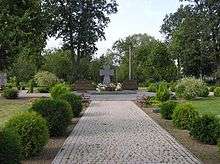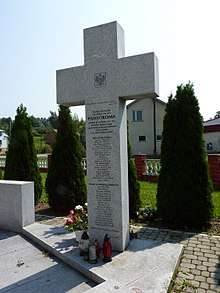Pawłokoma massacre

The Pawłokoma massacre refers to the murder of Ukrainians by Poles at the end of World War II in Pawłokoma 40 km (25 mi) west of Przemyśl in Poland, on March 3, 1945. In the period before the outbreak of World War II there were 1370 residents including 1190 Ukrainians, 170 Poles and 10 Jews.[1]

Prelude
After the Soviet invasion of Poland in accordance with the Nazi–Soviet Pact, Pawłokoma was annexed by the Soviet Union to the Ukrainian SSR along with the entire south-eastern Kresy region of Poland, and placed in the Drohobych oblast, until 1941. According to Ukrainian-Canadian historian Petro Potichny,[2] during the Soviet occupation sixteen villagers were arrested by the NKVD and disappeared. During the subsequent German occupation, nine Ukrainians were arrested and 193 were deported as Ostarbeiter to Germany. However, Ukrainians were favored by the German Nazi administration and 10 even joined SS "Galizein".[3] Ukrainian denunciations caused 3 Poles and one pro-Polish Ukrainian woman to be sent to Auschwitz-Birkenau. They were also responsible for the death of a local AK member, Józef Michalik.
Among those killed by the Polish underground in 1943 was the active community leader, teacher and bandurist Mykola Levytsky.[4] Levytsky, alongside Ivan Karp, Eugenia Trojan and Ivan Szpak were all members of Ukrainian nationalist movement that advocated cleansing area off ethnic Poles. The move caused local Ukrainian chauvinists to stop their agitations for a time being.[5] The situation was worsened when the Ukrainian Auxiliary Police arrested local AK members. Poles attempted to free them from a prison in Jawornik Ruski, but discovered that they weren't there anymore.[3] As a retaliation, Germans together with the Ukrainian Auxiliary Police pacified Polish village Dylągowa.[6]
On January 21, 1945 a unit of the Ukrainian Insurgent Army appeared in the village and kidnapped seven Poles and one pro-Polish Ukrainian woman, including the commune leader of Pawłokoma — Kacper Radoń. They never returned to the village, and were assumed to have been killed. The Polish community tried to discover their place of burial from the Ukrainians. However there was no response. Poles from nearby Dynow and from Pawłokoma appealed to the mayor of Powiat to send troops to extract information about the missing people. These meetings turned into anti-Ukrainian demonstrations. Retaliation occurred.[7]
According to another story reported by a historian Eugeniusz Misiło, the Poles who were kidnapped and murdered in Pawłokoma and in neighboring villages by UIA, were actually kidnapped by the Soviet NKVD in an attempt to start a series of retaliations.[8]
Massacre
On 2–3 March 1945, 365[9] (or 150 according to Zdzislaw Konieczny) Ukrainian and a few Polish inhabitants of Pawłokoma were killed, by a former[10] Armia Krajowa unit,[11] commanded by Józef Biss "Wacław" aided by Polish self-defense groups from nearby villages. The victims were held in a local church, interrogated and then taken to a local cemetery where they were executed.[11] Women with small children (below 10 years old) were spared.[12] According to historian Zdzisław Konieczny, the AK group killed some 150 Ukrainian men in Pawlokoma, while women and children were spared and ordered to march to Ukraine.[13][14]
An inscription on the Ukrainian memorial in Pawłokoma places the number of victims of the 1945 massacre at 365.
The massacre was believed to be an act of retaliation for an earlier murder by Ukrainian Insurgent Army of 9 (or 11) Poles and for the anti-Polish genocide in the wider region.
Aftermath
On September 4, 1945 after interrogation by the Soviet government, Józef Biss was sentenced to seven years imprisonment for involvement in anti-Communist activities and evasion of a military service.[15]
On the night of October 4, 1945 UIA attacked the village killing up to 20 Polish civilians who settled there, as well as in February 1946, UIA carried another attack killing further civilians.[16]
The Ukrainian church in which the Ukrainian villagers were murdered was destroyed by the Roman Catholic parishioners of the village in 1965. Part of the bell tower remains.[17] The Ukrainian cemetery was transformed into a dump yard.[18]
Several bodies of the victims were exhumed in 1952. The Polish Institute of National Remembrance (IPN) has been conducting an investigation of the crime since 20 September 2001. The ongoing investigation is (as of May 2006) still inconclusive.
On May 13, 2006 Polish president Lech Kaczyński and Ukrainian president Viktor Yushchenko attended a ceremony at the site to pay tribute to the victims, and to encourage historical reconciliation between Poland and Ukraine. After celebrating a panychydy, the presidents also paid tribute to all Polish victims who died in Pawłokoma.
Controversy
While sources differ on specific issues like the number of the victims or details of the massacre, all agree that the Ukrainian villagers were murdered by Poles and that an Armia Krajowa unit (AK was disbandend in January 1945) either participated directly or assisted in the killings. The Pawłokoma Memorial places the number of victims at 365, the figure supported by IPN and a number of Polish historians[19] It is, however, questioned by a Polish historian Zdzisław Konieczny, author of a book on the Pawłokoma massacre,[20] claiming that some 150 Ukrainian members of UIA had been killed, while women and children were ordered to leave in the direction of Bircza and Sanok.[21]. Poles who participated in the event, claim that at most 120-150 Ukrainian men were killed, and there's no way that the graves they dug could fit 300 people.[22] According to Ukrainian historian, Eugeniusz Misiło Józef Biss claimed that 80 people at most were killed that day.[23]
Another controversy resolves about the identity of the victims; Polish soldiers named Kowal and Hayduk claimed that all the Ukrainian men killed were members of nationalist UIA and members of the pro-Nazi UAP.[24] Ukrainian women and children were all spared.[25]
See also
Notes
- ↑ http://tyzhden.ua/History/43977 Тепер тут буде Польща!
- ↑ Rudling, Per A. (November 2011). "The OUN, the UPA and the Holocaust: A Study in the Manufacturing of Historical Myths". The Carl Beck Papers in Russian & East European Studies. Center for International Studies, University of Pittsburgh. Number 2107: 59. ISSN 0889-275X. Note 222. John Pancake (January 6, 2010), "In Ukraine, a movement to honor members of the WWII underground sets off debate." The Washington Post. "One of the key figures involved in the research is Peter J. Potichnyj. Born in a Ukrainian family in a village in what was then eastern Poland, Potichnyj experienced the horrors of the war firsthand. Soviet Secret Police executed his father. Poles massacred most of the people in his village. In 1945, at the age of 14, he joined the Ukrainian Insurgent Army, or UIA, and fought against the Soviets until 1947. He eventually became a historian at McMaster University in Hamilton, Ontario, and helped edit 77 volumes about the Ukrainian underground."
- 1 2 Z. Konieczny, Był taki czas. U źródeł akcji odwetowej w Pawłokomie Przemyśl 2005, ISBN 83-88172-26-3, p. 34-35.
- ↑ "16 квітня мешканці Львівщини вийдуть на толоку". 30 March 2016.
- ↑ Z. Konieczny, Był taki czas. U źródeł akcji odwetowej w Pawłokomie Przemyśl 2005, ISBN 83-88172-26-3, p. 36-37.
- ↑ Z. Konieczny, Był taki czas. U źródeł akcji odwetowej w Pawłokomie Przemyśl 2005, ISBN 83-88172-26-3, p. 41.
- ↑ Zdzisław Konieczny, Był taki czas. U źródeł akcji odwetowej w Pawłokomie, Przemyśl 2005, ISBN 83-88172-26-3
- ↑ (Misiło, Pawłokoma ..., p. 20)
- ↑ Zhurzhenko, Tatiana (2013). "Memory wars and reconciliation in the Ukrainian-Polish borderlands: geopolitics of memory from a local perspective". In Mink, Georges; Neumayer, Laure. History, Memory and Politics in Central and Eastern Europe: Memory Games. Palgrave Macmillan. p. 186.
- ↑ AK was disbanded 19 January 1945
- 1 2 Jan Maksymiuk: Ukraine, Poland Seek Reconciliation Over Grisly History in Radio Free Europe NEWS article, May 12, 2006
- ↑ Misiło, Pawłokoma ..., p. 13
- ↑ Zdzisław Konieczny, Był taki czas. U źródeł akcji odwetowej w Pawłokomie, Przemyśl 2005, ISBN 83-88172-26-3
- ↑ Jews, Poles, and Slovaks: A Story of Encounters, 1944--1948, Anna Cichopek-Gajraj, ProQuest LLC.
- ↑ "Józef Biss - historia jednego z wrześniowych żołnierzy - Jan Lucjan Wyciślak". www.rodaknet.com.
- ↑ Z. Konieczny, Był taki czas, s.68
- ↑ "16 квітня мешканці Львівщини вийдуть на толоку". 30 March 2016.
- ↑ "Павлокома. Пробачити, але не забути". Club-tourist.
- ↑ Sowa, Stosunki ..., p. 286
- ↑ Konieczny, Był taki czas ...
- ↑ Maksymiuk, Ukraine...
- ↑ Z. Konieczny, Był taki czas, s.60-61
- ↑ E. Misiło, Pawłokoma..., p.34-35
- ↑ Z. Konieczny, Był taki czas, s.55-56
- ↑ E. Misiło, Pawłokoma..., s.31
References
- Jan Maksymiuk: Ukraine, Poland Seek Reconciliation Over Grisly History in Radio Free Europe NEWS article, May 12, 2006
- (in Polish) Lucyna Kulińska: "Pawłokoma" in Dziennik Polski nr 103, Kraków 2006
- Misiło, Eugeniusz (2006). Pawłokoma 3 III 1945 r. (in Polish). Warszawa: Ukar. ISBN 83-60309-02-7.
- Sowa, Andrzej L. (1998). Stosunki polsko-ukraińskie 1939-1947 (in Polish). Kraków. OCLC 48053561.
- Konieczny, Zdzisław (2000). Był taki czas. U źródeł akcji odwetowej w Pawłokomie (in Polish). Przemyśl.
- (in English) Poland, Belarus & Ukraine Report: May 12, 2006 in Radio Free Europe.
Coordinates: 49°48′55″N 22°17′18″E / 49.815196°N 22.288239°E